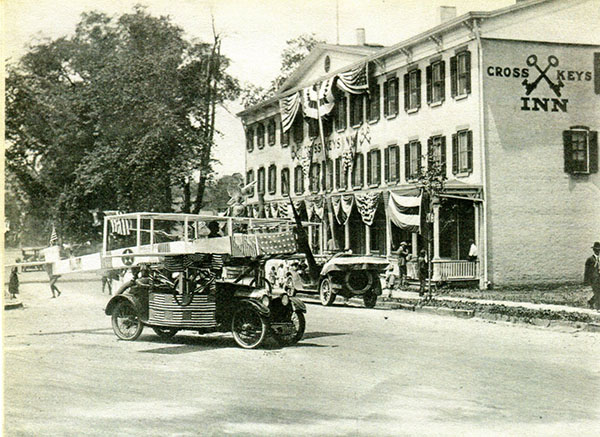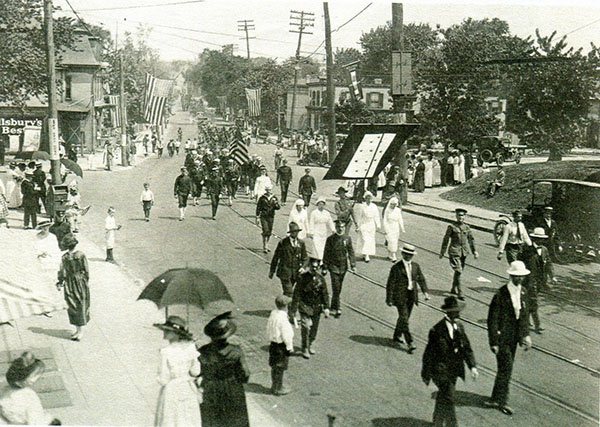Submitted by Al Shipley, City Historian and Rahway Library Research Consultant
When World War I ended on November 11, 1918, Rahway factories blasted their sirens, churches rang their steeple bells, and citizens ran into the streets and cheered. It was the end of a war the likes of which the world had never seen before, and with victory came a belief that mankind would never again allow such horror to repeat itself. City officials realized immediately that a Victory Day celebration had to be planned and agreed that the next year’s Fourth of July observance would be the perfect venue.
Excitement for the event built over the next eight months as committees were formed to oversee the many details of preparation. Mayor David H. Trembley, John Farrell, a former councilman, ex-mayor Harry Simmons, and Nelson M. Turner, secretary of the committee were selected to be in charge of the celebration. A finance committee, consisting of 48 prominent members of the community, was established to solicit donations from institutions and citizens to fund the event. A reception committee for soldiers and sailors was set up to run the programs to honor the returning veterans, and a parade committee was formed to assemble the largest parade in the city’s history. There were also committees to take care of refreshments and decorations and a committee to organize a block dance.
When Independence Day, 1919, finally arrived, the city was awakened at 7:00 when factory whistles and church bells were sounded throughout the neighborhoods. The sun rose early and the forecast called for temperatures in the nineties, but there was no sign of rain, assuring that the grand parade, scheduled for a 10:00 start, would commence without a hitch. The line of march would cover over three miles and the marchers would traverse fifteen different streets and avenues. Homes along the entire route were decorated with American Flags and patriotic bunting. The procession was a mile long, with over 2,000 participants filling eight divisions.
Approximately 135 soldiers who had served in the war marched as did Red Cross workers, and members of the Grand Army of the Republic (Civil War veterans). City officials, police and firemen, and dignitaries representing the Army and Navy participated. Members of civic clubs including the Loyal Order of Moose, Odd Fellows, Yacht Club, and the Daughters of the American Revolution marched as did the employees of many Rahway companies. Boy Scouts, Camp Fire Girls, and students from St. Mary’s Parochial School were also in the parade. Bands and floats were interspersed throughout the procession. It was reported that the most touching part of the line was the automobiles carrying the mothers of the soldiers who had made the Supreme Sacrifice.
At the conclusion of the parade, the men who had been in the military marched to the Empire Theater on Irving Street where they were treated to an excellent dinner prepared by Red Cross workers. Former Mayor Simmons welcomed the men and on behalf of the city expressed his appreciation for their brave service during the war. A lively quartet, several soloists, and dancers provided the entertainment during the banquet. At the end of the affair, each soldier was given eight cigarettes and a cigar.
Following the dinner, a procession was again formed and the men, led by a band, proceeded to Riverside Park (Veterans’ Field) where Mayor Trembley gave a stirring speech and awarded a medal to each soldier. It was estimated that over 600 Rahway boys had enlisted in the Great War and of that total 260 medals were given out to those in attendance.
The concluding event of the day was an evening block dance staged on Main Street between Cherry Street and Milton Avenue. Music was provided by bands positioned at each end of the street. Hundreds of couples gathered to enjoy the evening and close out the celebration.
At the time, it was believed that World War I was the “war to end all wars.” The citizens of Rahway like the citizens of countless numbers of cities and towns across the nation would hold lavish programs to celebrate the end of warfare. At the time, with the prospect of a future of world peace, there was good reason to believe that July 4, 1919 would be called the “Greatest Day in Rahway’s History.”

(above) An automobile carrying a replica of the NC-4, the airplane that made the first successful trip across the Atlantic, was one of the many floats entered in the parade.

(above) Red Cross volunteers carry the Gold Star Service Flag as the parade moves along Irving Street having just passed Central Avenue.
